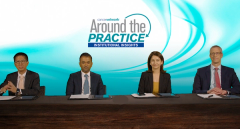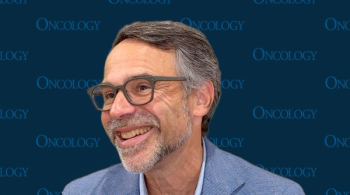
Managing AEs Associated With Bispecifics in RRMM
Closing out their discussion on relapsed/refractory multiple myeloma, experts consider adverse event management in patients receiving bispecifics followed by future directions in care.
Episodes in this series

Transcript:
Noopur Raje, MD: I want to touch on what you mentioned earlier, Andrew—toxicity—and Omar, I am going to turn this over to you. The patient that Andrew presented had grade II CRS [cytokine release syndrome] with change in mental status. It’s hard to differentiate between true ICANS [immune effector cell-associated neurotoxicity syndrome] neurotoxicity vs CRS. There seems to be an overlap, which appears to be the case here; with this one we gave tocilizumab and steroids. Typically you take care of both CAR [chimeric antigen receptor] patients. You have taken care of patients who are getting bispecific T-cell engagers. Can you comment on the incidents of CRS and neurotoxicity in general, and more specifically with bispecific T-cell engagers? When do you worry about these most, and what are the treatment strategies that we have in place?
Omar Nadeem, MD: When this first came about with CAR T-cell therapy, we started to see this syndrome, now called CRS, and we are very familiar with management of that in the CAR T setting. The majority of patients with CAR T-cell therapy end up getting CRS. The timing can be different depending on the product. It can happen early with ide-cel [idecabtagene vicleucel], it happens about a week later with cilta-cel [ciltacabtagene autoleucel], but it’s more predictable. We now know what to look for. The rates are high, although early intervention may limit the incidents of higher-grade CRS, which is something we have learned over the years as we have taken care of patients. Across the board, the incidents of CRS is a lot lower with bispecific antibodies. It’s falling more in that 60% to 70% range, whereas it’s close to 90%-plus with most of the CAR products. The other good news is, it’s low grade, the CRS, as Andrew mentioned, the rate of tocilizumab used in steroid use, it’s a lot lower. I think that may translate eventually, which is our hope, that it’s going to be easier to give. You give it in more settings, and you don’t necessarily have to have people in the hospital for long in the management of these toxicities. With bispecific antibodies, you see a lower incidence and grade of CRS. In terms of neurological toxicity, it’s the same story. We haven’t seen much neurological toxicity with BCMA [B-cell maturation antigen]-targeted products in myeloma compared to some of our other counterparts, for example in lymphoma. There is a question of delayed neurological toxicity that exists with cilta-cel, but that’s a separate topic. When you think about a traditional ICANS in this setting, you see very low incidence of neurological toxicity with bispecific antibodies, also with more CAR products. In terms of management, we now have teams equipped to handle this in the hospital; we have tocilizumab, steroids, and other agents to break the cycle. Most patients are able to get through that window, and usually it’s limited to the first step-up dosing. It’s more predictable, finite, and then once you get them through that, most of the time they are in the clear.
Noopur Raje, MD: Absolutely, I think that’s well said. We have had an incredible discussion. I am going to go around the panel and ask each of you to tell me what you’re most excited about for the future in myeloma care. We will start off with you, Jacob.
Jacob Laubach, MD, MPP: Our discussion today highlighted the fact that we have an abundance of high-quality regimens for the newly diagnosed. The idea that we must save a certain agent or lines of treatment for later really doesn’t apply now. We apply our best available treatment as induction therapy, in some instances followed by transplant. We can tell patients we have effective therapies for them in the future when they relapse.
Noopur Raje, MD: Well said. Omar?
Omar Nadeem, MD: We have come a long way in a short period of time over the last 5 to 10 years with these new agents that have come about. Now it’s putting the puzzle together about which patients benefit from which therapy: the high-risk patients, the early relapse patients, some of the patients that you want to help live as good of a life as other myeloma patients that are living now, sometimes several decades. You want to be able to convert those patients into those long-term survivors until we can hopefully cure the disease. I am excited about figuring out where all these therapies would fit into which patient population.
Noopur Raje, MD: Absolutely. Andrew?
Andrew J. Yee, MD: I completely agree. There is so much excitement that’s evolved with all these new classes of agents, new therapies. I am looking forward to seeing how we can apply these newer modalities in terms of targeting BCMA [INAUDIBLE] saving it for relapse or refractory disease. I would love to see how it plays when used earlier in the disease course. Secondly, I love to think about adding therapies and combining them. It would be great to come to the point where we are curing patients and [seeing] how you can best identify patients where we can peel back on the therapy. I think all patients would love to be able to peel back on some of the treatment that they are on.
Noopur Raje, MD: Absolutely. Treatment fatigue is a real thing. With that, I would love to thank this tremendous faculty for this very engaging discussion. Thank you for being here today to discuss treatment of patients with myeloma. This is brought to you by Cancer Network. Thank you to our viewing audience; we hope you found this interactive discussion informative and useful in your clinical care for patients with myeloma. Thank you.
Transcript edited for clarity.
Newsletter
Stay up to date on recent advances in the multidisciplinary approach to cancer.


















































































